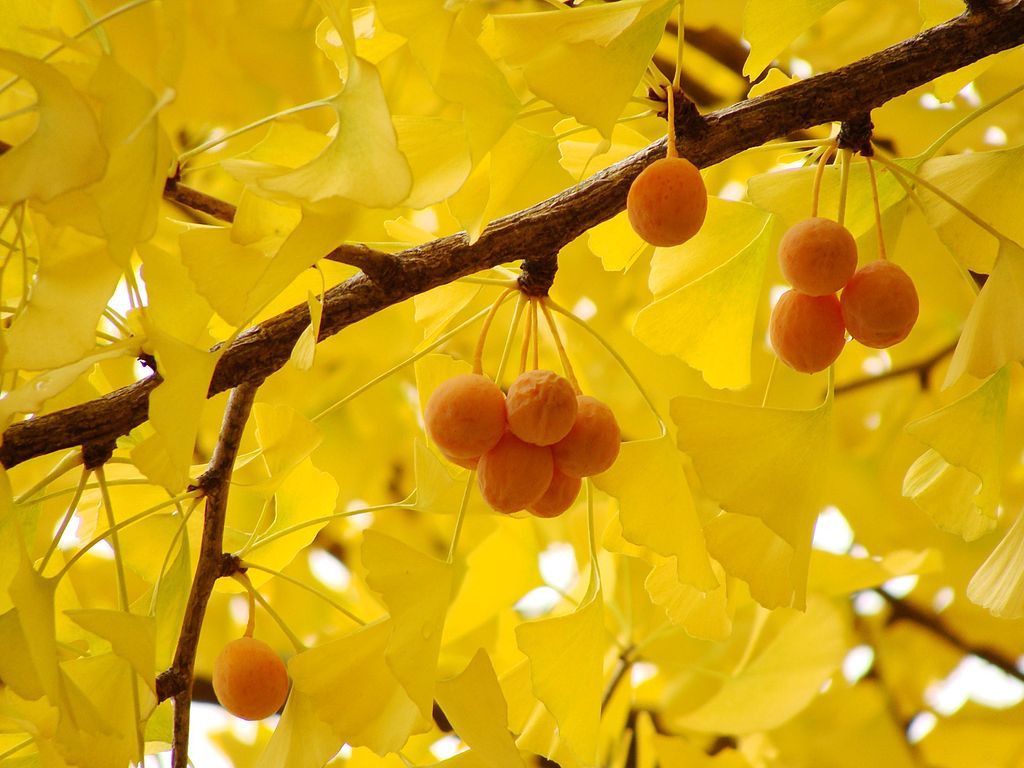
While perusing the Sibley Guide to Trees (which I quote below) I ran across an amazing name for ginkgos: Stinkbomb Tree.
The name is new to me but I know how they got it. In autumn the ginkgo’s fleshy, ripe fruit falls from the female trees and is easily crushed underfoot. If you step on it you’re sorry. It’s slippery and smells like vomit.
Ginkgo trees (Ginkgo biloba) are living fossils from the Triassic, the only plant in their division to survive into the modern age. Though classified as trees, ginkgos have a lot in common with ferns. Their fan-shaped leaves have a fern-like vein system. Each tree is either male or female and the seeds are “fertilized by motile sperm as in cycads, ferns, mosses and algae.”
There are probably no wild ginkgos left on earth but they survived and re-naturalized in Asia because humans cultivated them for their religious and medicinal significance, especially in China.
Ginkgos cope well with pollution and confined root systems so they’re often planted in cities. How hardy are they? Six ginkgo trees were the only living things to survive within a 1-2 km radius of the 1945 Hiroshima atomic blast.
Of course that wasn’t known when they were chosen to beautify Pittsburgh during our Smoky City days. Both male and female trees were planted in our city parks in the late 1800s. Nowadays female ginkgos are often banned because of their “stinkbombs” but we have some on Schenley Drive near Phipps Conservatory and on Highland Drive near Highland Park.
Very soon our ginkgos will turn a beautiful bright yellow and their leaves will fall all at once. If you time it right, you can stand below a yellow ginkgo on a windless day and the leaves will drop around you like snow. But watch where you step…
(photo by Aomorikuma via Wikimedia Commons, GNU Free license. Click on the caption to see the original.)
There were a number of ginko trees that lined a street near my office when I worked on Capitol Hill in Washington. Walking down the sidewalk was like running the gauntlet. There is nothing worst than trying to look professional while smelling like you stepped in dog doo!
According to my Dad, ginkos were known as “pooberry trees” on University of Delaware campus. He didn’t mention anyone calling them stinkbomb trees.
There are some near the pool at Riverview Park.
There are several at the intersection of Beeler with Wilkins, in front of the yellow brick row houses. Very pretty to look at, but from the other side of the street! Anne
Oh, yeah, there are a bunch near Phipps. I always thought they smelled like dirty stinky feet! Phew!
I lived on D Street between 9th Street to 14th street NE growing up. Does anyone know where the trees were in the 40’s and 50’s. I remember them but not exactly where they were. Just curious.
17th and Gayle NE in the 50s
I have one in front of my home in the Bronx, New York how do I get the Parks Dept to remove it? Every year I spend thousands of dollars washing down my sidewalk.Thank you.
Carmen, you’ll have to ask the City. However, in many cities trees are protected because they are so scarce. I imagine the Bronx is one such location.